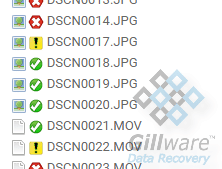Clicking Western Digital (WD My Passport) Results in Damaged Platters and Data Loss
Dropped your drive and now it clicks?
If your Western Digital My Passport hard drive is clicking, you’ve come to the right place to help. Read on to find out what makes your hard disk drive click, how much danger the files on your hard drive might be in, and what you can do to retrieve that data.
Damaged platters don’t always equal lost data

Clicking Western Digital My Passport Not Recognized – The Dreaded “Click of Death”
A healthy hard drive clicks once upon starting up. This is the sound of the read/write heads moving up the ramp that guides them into place over the data storage platters. When a hard drive’s read/write heads fail, though, they produce an altogether nastier clicking noise. As the failed read/write heads blindly sweep over the platters and return to their starting position over and over again, they produce a rhythmic and repetitive clicking noise. This noise does not bode well for the hard drive—computer repair professionals call it the “Click of Death” for a reason.
When a hard drive starts clicking, the damage to the read/write heads can be mild, moderate, or severe, but there’s no way to tell how bad the situation is without removing the drive’s faceplate and taking a peek at its platters. And in the following case study, that was exactly what our data recovery engineers would have to do in the safe haven of our lab’s cleanroom workstations.
Clicking Western Digital Hard Drive Recovery: WD My Passport Not Recognized
All of the data on your hard drive lives on the surfaces of the hard disk platters within the drive. Most hard drives have multiple platters, writing data to both sides of each. When read/write heads fail, some fail more severely than others—which can lead to one platter surface sustaining heavier damage than its neighbors.
When our cleanroom engineers examined this hard drive, we found ourselves looking at a dire data recovery situation. Of the two platters inside this clicking Western Digital hard drive, the top surface of the topmost platter had suffered severely. Concentric rings on the platter’s surface had been gouged out by the mangled read/write head. This is the severe hard drive malady we refer to as “rotational scoring”.
But the other surfaces of the platters had no visible damage, so our engineers weren’t about to write this case off as a loss. To salvage the data from the remaining platter surfaces, our engineers took each platter and carefully polished them.
Rotational scoring scrapes the thin layers of magnetic alloys holding your data off of the platters’ surfaces. The scraped-off material becomes dust, which can settle all around the hard drive’s insides. The dust can embed itself in the surfaces of the platters. Even these tiny particles are much, much larger than the distance between the read/write heads and the platter surface. The dust has to be removed in order for data recovery work to continue. This is where our burnishing technology proves its worth. Without a way to remove the dust and polish these platters, it would have been impossible to salvage any data from this drive—even though only one platter surface had been scored. This technology is just one of the many things that set Gillware Data Recovery apart from other data recovery companies.
If you have a clicking Western Digital hard drive

Clicking Western Digital Hard Drive Recovery Case Study:
The client in this data recovery case came to Gillware with a clicking Western Digital hard drive. They had been using their Western Digital My Passport to store their research documents, photos, and videos—until the drive went belly-up. Of all the sounds a hard drive makes—most good, some bad—none is more infamous than the “Click of Death”. Unfortunately, the read/write heads inside this client’s hard drive were as dead as a doornail.
Western Digital Data Recovery Results
Drive Model: Western Digital WD10JMVW-11AJGS3
Drive Capacity: 1 TB
Operating System: Mac
Situation: Western Digital My Passport drive not detecting. Drive started clicking.
Type of Data Recovered: Word and PDF documents, photos, videos
Binary Read: 4.4%
Gillware Data Recovery Case Rating: 4
After burnishing the platters and cleaning off the dust and debris, our engineers replaced the drive’s failed read/write heads. After finding a compatible donor set, we could start pulling data off of the client’s clicking Western Digital hard drive.

Data Recovery Software to recover
lost or deleted data on Windows
If you’ve lost or deleted any crucial files or folders from your PC, hard disk drive, or USB drive and need to recover it instantly, try our recommended data recovery tool.
Retrieve deleted or lost documents, videos, email files, photos, and more
Restore data from PCs, laptops, HDDs, SSDs, USB drives, etc.
Recover data lost due to deletion, formatting, or corruption

Due to the severe rotational scoring, it just wasn’t possible to fully recover all of the client’s data from their failed hard drive. But with only one of the four surfaces of the platters scored, there was still a good chance that at the very least, the client’s most important files had survived this clicking catastrophe.
Our engineers completely recovered 49.8% of the client’s files. In addition, we had partially recovered many of the client’s files as well. We sent the client a list of the recovered files so they could make sure their important files were among the living. In situations like this, it is up to them to decide whether or not our efforts have paid off.
The client reviewed the list of recovered files carefully and was overjoyed at the results. We had successfully recovered, with no corruption, the client’s most critical photos, videos, and documents. Severe rotational scoring hadn’t stopped our engineers. This Western Digital recovery case was a smashing success.
